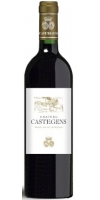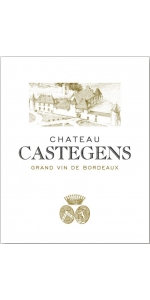Wine from Chateau Castegens

The Château overlooks the Dordogne valley above the village of Castillon-la-Bataille, adjacent to its prestigious neighbour Saint Emilion, only 8 km away. The vineyards are planted on the upper part of predominantly south facing slopes which provide excellent natural drainage and optimum exposure to the sun.
The origins of the estate date back to the early 15th century, not long before the famous battle of Castillon took place in 1453, which ended the Hundred-Years war between the English and the French. With the two other major events that occurred the same year (invention of printing by Gutenberg in Germany, fall of Constantinople in Turkey), most historians consider 1453 to mark the endof the Middle Ages and the beginning of the Renaissance. Highlighting the property’s historical significance, each summer, the estate pays host to the re-enactment of this battle, an epic spectacle with 600 actors and cavaliers.
Château Castegens and its vineyard have been in the same family for 160 years. Curator of the tradition of excellence within the Appellation, the current owner, Baron Jean-Louis de Fontenay, since 1994, has been continuously elected by his peers the Grand Master of the « Confrérie des Chevaliers des Côtes de Castillon ».
Côtes de Bordeaux – Castillon is one of the most ancient wine region in the Bordeaux area,
Area under vine : 28 hectares (estate’s total surface is 120 hectares)
The soil is made of clay and limestone, with an emergence of flint.
The vineyard is planted with 80% Merlot, 18% Cabernet Franc, 2% Cabernet Sauvignon
The average age of the vines : 30 years old - Density : 5000 plants / ha
Viticulture
Leaf thinning on one side, green harvesting on the youngest vines, minimising of environmental impact.
Average yield : 45 hectolitres per hectare
Winemaking
Temperature controlled fermentation, micro-oxygenation, hydraulic vertical wine press.
Ageing : 12 months in French and American oak barrels (a third is renewed each year).
Chateau Castegens Cotes de Bordeaux Castillon is made from 80% Merlot, 18% Cabernet Franc and 2% Cabernet Sauvignon.
The wine boasts an intense, deep and lively red color. The nose offers black fruit, blackberry, cigar box, licorice, some delicate and integrated oak flavors as well. The mouth is full of fruit flavors, spice and fine toasty flavors. The structure is rich, but the tannins are well integrated already. The finish is long and a slight mintiness give the wine a great length and some purity.
Pairs great with meat and vegetables on the grill.
- back
Selected Options
Wineries
Categories
Pricing
Countries
Regions
Grape Types
Wineries
Organic/Free Shipping
Faust Cabernet Sauvignon is made from 85% Cabernet Sauvignon, complemented with Merlot, Petit Verdot and Cabernet Franc.
Cabernet’s classic aromas and flavors star in the 2022 Faust Napa Valley. Delicate violet notes lift the dark fruit on the nose—black currant and briary blackberry—layered with pungent forest botanicals, leafy tobacco, graphite, and toasted spice. The velvet of fine-textured tannins backs expressive red fruit flavors on a complex palate, both sweet and savory with mocha and minerality, juicy ripe fruit and freshness.
Review:
Deep garnet-purple colored, the 2022 Cabernet Sauvignon features scents of fresh blackcurrants, blueberries, and black raspberries, plus suggestions of pencil shavings and black olives. Full-bodied, the palate bursts with evocative black fruit flavors, supported by grainy tannins and bold freshness, finishing on a ferrous note. (LPB)
-Wine Independent 93 Points
Holocene The Black Square Cabernet Sauvignon is made from 100 percent Cabernet Sauvignon.
There is something ethereal about Cabernet Sauvignon grown in the cobblestone soils of the Walla Walla Valley. This region offers aromatic exuberance, elegance, finesse, a polished texture, layered complexity, and remarkable length. It is a place where one can craft a singular, stand-alone example of this varietal—unique not only in the United States but worldwide—while still echoing some of our favorite wines from Bordeaux.
In 2022, Winemaker Todd Alexander embarked on a new (yet familiar) journey that he had been patiently awaiting the perfect moment to explore. The Black Square is in its inaugural vintage, and this 2022 is 100% Cabernet Sauvignon grown in the Rocks District of Milton-Freewater, Oregon, which is part of the Walla Walla Valley.
The Black Square embodies elegance and grace framed by great structure, supple texture, and acidity to ensure longevity. It shows ample fruit with complex savory notes. This is not a heavy wine that is monolithic and dull—there are already plenty of those available. This wine offers a unique expression of Cabernet; it may be the most delicious wine Todd Alexander has ever crafted, venturing into new territory for Rocks District Cabernet Sauvignon.
Review:
As black as squid ink, The Black Square is balance personified. A concentrated blackberry aroma seems as dark as the wine's name, with equally dark espresso, olive and charred steak notes joining it in the abyss. A dark plum and ripe boysenberry flavor combo is accompanied by traces of salty Mission olives, wet slate and silky smooth tannins. The one bright feature illuminating the way is the wine's amped-up acidity. None so black
-Wine Enthusiast 98 Points Number 5 in the Top 100





